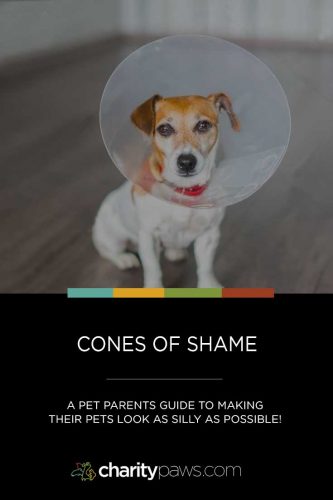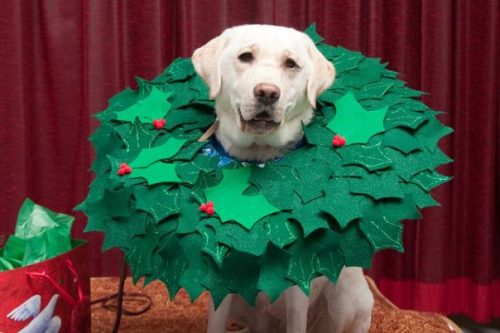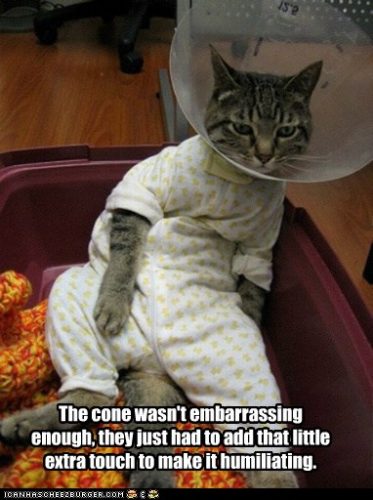
Why do we say it is the ultimate cone of shame guide? Well, because we tried to give you everything you need to know – from how to buy one – to dogs showing their feelings while wearing one!
Just about every pet parent has experienced that moment when the vet tells you – yep, your baby needs to have some surgery or has an allergy or injury that needs to be kept protected.
Whether a traditional spay/neuter of a new puppy or if you rescued a dog that has something more serious – one of the worst parts of a surgical procedure is not the surgery or even skin condition at all – but that damn plastic thing, AKA – the Cone of Shame!
The cone of shame is more traditionally called an Elizabethan collar or e-collar for short. Other names that it is often called is pet cone, recovery cone or sometimes even a lampshade.
The History Of The E-Collar.
The history of how the “cone of shame” play on words came to be is rather controversial with many reporting the phrase was first coined by the 2009 movie UP when a Golden Retriever pup named Dug was placed in a cone as punishment by has pack.
But I am old and could swear I had heard of the term way before that!
There was a patent for a “protective device for dogs” done back in February of 1959 by Frank L. Johnson which seems to resemble the most common type of dog or cat cone your vet may provide.
There has been other mentions of people inventing the “cone of shame” – for example, Joel Ehrenzweig has been mentioned as the inventor in several articles, but we could not find a patent under his name. There are other patents for various versions of the cone since the original patent as well.
What An E-Collar Is For.
When your pet gets surgery or has injuries it is important to keep them safe from licking or tearing at it.
Think about how itchy and uncomfortable you get when you get a cut or injury that needs to heal or have medicine put on it – typically it will itch, burn or just be annoying.
It is no different for dogs.
Even something as simple as putting medication on a wound could result in them licking it off because they do not like it.
An Elizabethan cone, or e-collar, is recommended to prevent your dog or cat from being able to reach around to bite, scratch or lick at their wounds which in turn helps them heal faster.
Why The Traditional E-Collar Sucks.
Unfortunately, the most original and dated versions of these collars were made of hard plastic and were extremely uncomfortable for pets.
These are still commonly found in most veterinarian offices – in part because the plastic versions we would imagine are the cheapest ones you can get – and well, they just work the best,
But, the plastic versions are bulky and hard which can make it difficult for your pet to eat, drink or even just relax comfortably.
They are also difficult to get on pets since most would fight it and either you had to get the tabs together or try and tie strings to get it tight enough to stay on.
This is frustrating for both the pet and pet owner.
Alternatives To Traditional Hard E-Collars.
Thankfully there are other options available to you and your pet for making their lives happier while they are in recovery. So instead of the traditional plastic cone of shame, consider these options:
- Pet recovery clothing that will constrict their movement
- Inflatable e-collars
- Soft pliable cones
- Bite free collars
Let’s talk about these options a bit so you can see which may make the most sense for you!
Pet Recovery Clothing
Using pet clothing is the easiest way to bring your pet some safety and relief. In the past parents may have used items like t-shirts to keep their pets from scratching.
But now there are better options to protect them.
One of the best options is called the Suitical Recovery Suit that is actually vet approved and can withstand a good amount of abuse your pet might give it. It is perfect for pets with skin conditions as it does prevent them from licking and scraping at itches and sores.
The only thing you need to remember if you decide to go for this option is that you will need to let your pet “air out” and be sure to keep the clothing clean during their recovery. If they get too sweaty they may be more uncomfortable.
Suitical Recovery Suit
The Suitical Recovery Suit is our top pick for keeping your pet protected from scratching, surgical procedures and more. It keeps your pets skin protected from scratching and licking so it can heal properly and even works on incontinent dogs.
Made from a comfortable and easy to clean Cotton/Lyrca fabric – it allows for full movement keeping your pet as happy as can be while recovering! An added bonus is the ability for this suit to help with incontinence – a secret area houses a pad to catch any leaking.
A read snap allows you to easily allow access on dog walks for urinating and defacating.
Soft or Inflatable E-Collars
These are the most highly recommended options – you may pay a little bit more, but it is so worth it to know your pet is not only able to heal safely from whatever ails them – but will be comfortable while doing so!
There are a lot of different brands and styles out there but we found a few that we highly recommend based on consumer review, price and functionality. Most of the options below are perfect for both cats and dogs, you just have to make sure you measure your pet properly!
When is an inflatable collar more highly recommended?
The inflatable collars are highly recommended for pets with shorter
noses as they do not restrict the ability for the pet to eat and drink
and are better for mobility since their vision is not as impacted. Cats
also seem to have a preference for this type of collar as well.
Inflatable collars are usually easier to put on a pet and most commonly closes with a velcro closure.
We DO NOT recommend this option for dogs with longer snouts as they typically will still be able to reach their haunches and butts!
Bencmate Inflatable Collar
One of the most popular e-collar options we could find is the inflatable pet collar from Bencmate. With lots of happy customers and high ratings, this is definitely at the top of the list for inflatable cones.
The outer shell is a soft material for your pets comfort and the interior is a plastic tube that is easy to inflate and deflate. The outer shell can be removed for washing which is a great feature.
The collar also has inner ring loops so you can secure your pets regular collar and adjustable velcro makes it easy to fit a variety of pet sizes.
The No Bite Collar
There are a few other options that do not fall under any specific category and the no bite collar design is one of them – and we are seeing it being talked about as a great option for dogs and cats.
The Bitenot Collar is a large collar made from plastic and foam that almost resembles a neck brace. The premise is that this collar will restrict your pet from being able to turn their head to get to their injury. There is also another brand called KVP as well that creates a similar product.
They will still be able to eat and get around easily which is the real bonus to this option. Minimizing their discomfort is key!
Customers seem to like it more for dogs than cats — so you may want to really read the reviews to see if it is a good fit for your unique pets needs!

The No Bite Collar
There are a few other options that do not fall under any specific category and the no bite collar design is one of them – and we are seeing it being talked about as a great option for dogs and cats. The Bitenot Collar is a large collar made from plastic and foam that almost resembles a neck brace. The premise is that this collar will restrict your pet from being able to turn their head to get to their injury. There is also another brand called KVP as well that creates a similar product.
They will still be able to eat and get around easily which is the real bonus to this option. Minimizing their discomfort is key! Customers seem to like it more for dogs than cats — so you may want to really read the reviews to see if it is a good fit for your unique pets needs!
How To Make Your Own Cat or Dog E-Collar
If you have a pet that is not a crazy nut (like mine) – you may be able to construct something on your own that will work just fine. For example, simply rolling up some towels and wrapping them around their neck or finding an old sweatshirt or t-shirt that fits their body snugly are both great options for less active pets.
Other DIY collar tips are available with buckets (although we are not a fan of this idea at all) cardboard and even paper plates.
The towel collar is our most recommended as far as DIY options go! Animal behavior College created a really great video showing how to use a towel to make a dog or cat cone. Keep in mind this may not work on every pet – it depends on your pets demeanor and level of activity.
Animal behavior College created a really great video showing how to use a towel to make a dog or cat cone. Keep in mind this may not work on every pet – it depends on your pets demeanor and level of activity.
How To Properly Measure Your Pet For An E-Collar
This is so important! Making sure your pet has a proper fitting e-collar is critical to keeping them safe and healthy.
Our veterinarian recommended finding an e-collar that extends approximately 2-3 inches from the tip of their nose to ensure your pet cannot reach their wounded area.
There are 3 important parts to measure to find the right size cone:
- Neck circumference
- The length of their current collar they are wearing (if you are getting an e-collar that attaches to their collar)
- Length of your pet from the tip of their nose to the area where their collar typically falls on the neck.
Helping Your Pet Adjust To The E-collar
Of course some pets are easy and some, well not so much. Sadly I have never been blessed with an easy pet – and any collars worn in this house has always been a challenge and required a whole lot of babysitting!
Once you first place it on your pet – be sure you help them learn to navigate. Walk through the house with them – they will probably bump into things or struggle with the stairs – so you will want to help them “redirect” so they get used to the new way they need to walk around.
Make sure you tell them how good they are while re-learning things!
Make sure your pet can access their water and food with the collar on! If not, readjust or get a different collar. During recovery eating and drinking are so important and if they cannot do these things their healing will be impacted.
Do not leave your pet by themselves for the first day if you can! This is a big change and they may become stuck, frightened or injured – they need you!
The Cone of Shame Photo Wall
And what would any cone of shame post be without some great cone of shame memes and images. Some of these guys look pissed – while others seem pretty proud of themselves!
If you really want to see a whole new level of creativity with cones of shame – then here is a must visit Instagram account called Cones of Fame. Here is one sample from her account that we love!
View this post on Instagram


View this post on Instagram
Your Thoughts!
We want to hear your stories! If you have had a funny incident with a pet wearing a cone, have an image to share – or more importantly, have tips or tricks or recommendations on making cone wearing less stressful – please share!



